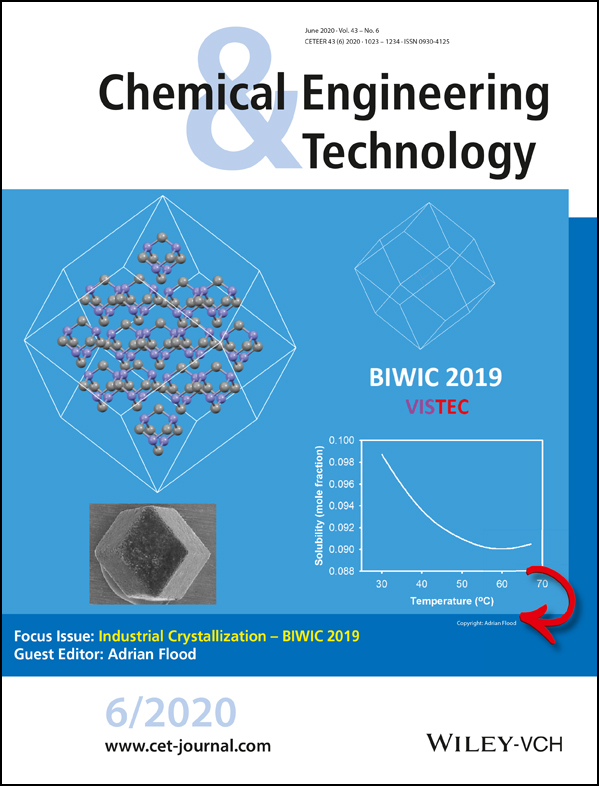Multidimensional Population Balance Modeling for Pathological Calcium Pyrophosphate Dihydrate Crystals in the Presence of Amino Acids
Correction(s) for this article
-
Multidimensional Population Balance Modeling for Pathological Calcium Pyrophosphate Dihydrate Crystals in the Presence of Amino Acids
- Volume 44Issue 3Chemical Engineering & Technology
- pages: 571-572
- First Published online: February 19, 2021
Corresponding Author
Aybala Gencaslan
Marmara University, Chemical Engineering Department, 34722 Goztepe, Istanbul, Turkey
Correspondence: Aybala Gencaslan ([email protected]), Marmara University, Chemical Engineering Department, 34722 Goztepe, Istanbul, Turkey.Search for more papers by this authorBercem Kiran-Yildirim
Marmara University, Chemical Engineering Department, 34722 Goztepe, Istanbul, Turkey
Search for more papers by this authorSibel Titiz-Sargut
Marmara University, Chemical Engineering Department, 34722 Goztepe, Istanbul, Turkey
Search for more papers by this authorCorresponding Author
Aybala Gencaslan
Marmara University, Chemical Engineering Department, 34722 Goztepe, Istanbul, Turkey
Correspondence: Aybala Gencaslan ([email protected]), Marmara University, Chemical Engineering Department, 34722 Goztepe, Istanbul, Turkey.Search for more papers by this authorBercem Kiran-Yildirim
Marmara University, Chemical Engineering Department, 34722 Goztepe, Istanbul, Turkey
Search for more papers by this authorSibel Titiz-Sargut
Marmara University, Chemical Engineering Department, 34722 Goztepe, Istanbul, Turkey
Search for more papers by this authorAbstract
A multidimensional population balance model was applied to elaborate the effects of amino acids on the crystallization mechanisms of calcium pyrophosphate dihydrate crystals. Breakage and growth terms defined in the model were expressed in two dimensions depending on the sizes. The exponential hyperbolic function based on the particle sizes was selected for expressing the growth. The model was resolved by using the finite differences method. It was detected that in the non-additive media, the growth along the length-1 is extremely dominant against both the growth along the length-2 and the breakage. However, it was discovered that the amino acids made the crystals more fragile, and the breakage at certain size ranges and certain concentrations of amino acids was the dominant mechanism. In any case, it was proven that both growth and breakage are suppressed considerably in the amino acid-containing media.
References
- 1 The Oxford Textbook of Medicine, 4th ed. (Eds: D. A. Warrell, T. M. Cox, E. J. Benz), Oxford University Press, Oxford 2003. DOI: https://doi.org/10.1093/ageing/afh119
- 2 A. Swan, B. Heywood, B. Chapman, H. Seward, P. Dieppe, Ann. Rheum. Dis. 1995, 54 (10), 825–830. DOI: https://doi.org/10.1136/ard.54.10.825
- 3 P. Gras, C. Rey, G. André, C. Charvillat, S. Sarda, C. Combes, Acta Crystallogr., B: Struct Sci. 2016, 72 (Pt1), 96–101. DOI: https://doi.org/10.1107/S2052520615021563
- 4 O. Ossi Horovitz, R. D. Pasca, Stud. Univ. Babes-Bolyai, Chem. 2017, 62 (2), 19–31. DOI: https://doi.org/10.24193/subbchem.2017.2.02
- 5 Z. Gao, S. Rohani, J. Gong, J. Wang, Engineering 2017, 3 (3), 343–353. DOI: https://doi.org/10.1016/J.ENG.2017.03.022
- 6 A. Gencaslan, P. Sayan, S. Titiz-Sargut, Chem. Eng. Technol. 2018, 41 (6), 1211–1217. DOI: https://doi.org/10.1002/ceat.201700671
- 7 J. Mydlarz, Cryst. Res. Technol. 1995, 30 (6), 747–761. DOI: https://doi.org/10.1002/crat.2170300604
- 8 F. Puel, P. Marchal, J. P. Klein, Trans. Inst. Chem. Eng. 1997, 75 (2), 193–205. DOI: https://doi.org/10.1205/026387697523444
- 9 R. Gunawan, I. Fusman, R. D. Braatz, AIChE J. 2004, 50 (11), 2738–2749. DOI: https://doi.org/10.1002/aic.10228
- 10
F. Puel, G. Févotte, FAC Proc. Vol.
2004, 37 (1), 595–600. DOI: https://doi.org/10.1016/S1474-6670(17)38797-9
10.1016/S1474-6670(17)38797-9 Google Scholar
- 11 M. Raphael, R. Sohrab, Chem. Eng. Sci. 1996, 51 (19), 4379–4384. DOI: https://doi.org/10.1016/0009-2509(96)00297-7
- 12 M. L. Raphael, Recovery and Kinetics Study of Isoelectric Precipitation of Sunflower Protein in a Tubular Precipitator, Ph. D. Thesis, University of Saskatchewan, Saskatoon 1997.
- 13 R. R. Fisher, Protein Precipitation with Acids and Polyelectrolytes: The Effects of Reactor Conditions and Models of the Particle Size Distributions, Ph. D. Thesis, Iowa State University, Ames, IA 1987.
- 14 C. E. Glatz, M. Hoare, J. Landa-Vertiz, AIChE J. 1986, 32 (7), 1196–1204. DOI: https://doi.org/10.1002/aic.690320717
- 15 A. Borsos, B. G. Lakatos, Period. Polytech. Chem. Eng. 2012, 56 (2), 65–69. DOI: https://doi.org/10.3311/pp.ch.2012-2.03
- 16 B. Szilágyi, P. Ş. Agachi, B. G. Lakatos, Powder Technol. 2015, 283, 152–162. DOI: https://doi.org/10.1016/j.powtec.2015.05.029
- 17 M. Iggland, M. Mazzotti, Cryst. Growth Des. 2012, 12 (3), 1489–1500. DOI: https://doi.org/10.1021/cg201571n
- 18 S. Elazzouzi-Hafraoui, Y. Nishiyama, J. L. Putaux, L. Heux, F. Dubreuil, C. Rochas, Biomacromolecules 2008, 9 (1), 57–65. DOI: https://doi.org/10.1021/bm700769p
- 19 M. Kaushik, C. Fraschini, G. Chauve, J. L. Putaux, A. Moores, in The Transmission Electron Microscope – Theory and Applications (Ed: K. Maaz), IntechOpen, London 2015, Ch. 6. DOI: https://doi.org/10.5772/60985
- 20 M. D. Higgins, Am. Mineral. 2000, 85 (9), 1105–1116. DOI: https://doi.org/10.2138/am-2000-8-901
- 21 D. J. Morgan, D. A. Jerram, J. Volcanol. Geotherm. Res. 2006, 154 (1–2), 1–7. DOI: https://doi.org/10.1016/j.jvolgeores.2005.09.016
- 22 A. H. Naqvi, J. L. Abraham, R. M. Kellman, K. K. Khurana, Cytojournal 2008, 5 (8), 1–5. DOI: https://doi.org/10.1186/1742-6413-5-8
- 23 M. Tavafoghi, M. Cerruti, J. R. Soc. Interface 2016, 13 (123), 1–13. DOI: https://doi.org/10.1098/rsif.2016.0462
- 24 P. Comeau, T. Willett, Sci. Rep. 2018, 8 (12700), 1–11. DOI: https://doi.org/10.1038/s41598-018-31058-5
- 25 S. T. Sargut, P. Sayan, B. Kıran, Cryst. Res. Technol. 2010, 45 (1), 31–38. DOI: https://doi.org/10.1002/crat.200900605
- 26 N. Spanos, P. G. Klepetsanis, P. G. Koutsoukos, J. Colloid Interface Sci. 2001, 236, 260–265. DOI: https://doi.org/10.1006/jcis.2000.7396
- 27 W. H. Lee, C. Y. Loo, K. L. Van, A. V. Zavgorodniy, R. Rohanizadeh, J. R. Soc. Interface 2012, 9 (70), 918–27. DOI: https://doi.org/10.1098/rsif.2011.0586
- 28 S. Koutsopoulos, E. Dalas, Langmuir 2001, 17 (4), 1074–1079. DOI: https://doi.org/10.1021/la000820p
- 29 S. Koutsopoulos, E. Dalas, J. Cryst. Growth 2000, 216 (1–4), 443–449. DOI: https://doi.org/10.1016/S0022-0248(00)00415-2
- 30 Z. Wang, Z. Xu, W. Zhao, N. Sahai, J. Mater. Chem. B 2015, 3 (47), 9157–9167. DOI: https://doi.org/10.1039/C5TB01036E
- 31 J. H. Joshi, S. Kalainathan, D. K. Kanchan, M. J. Joshi, K. D. Parikh, Arab. J. Chem. 2020, 13 (1), 1532–1550. DOI: https://doi.org/10.1016/j.arabjc.2017.12.005




